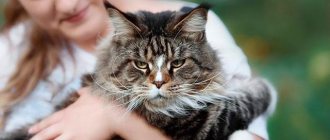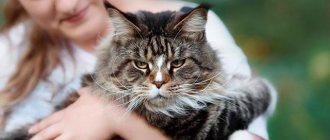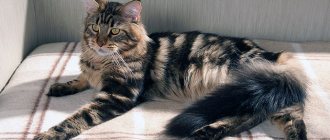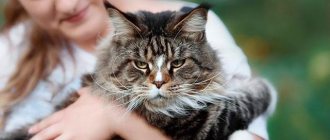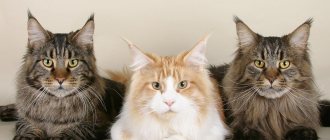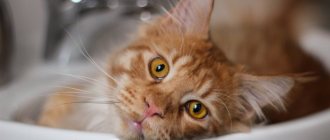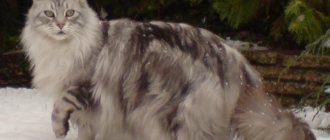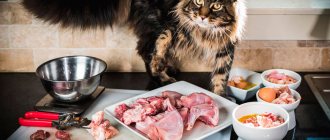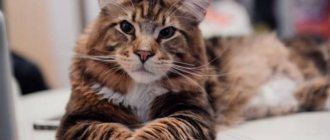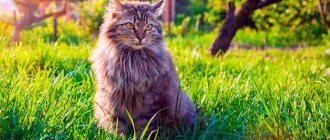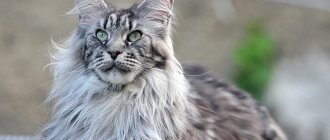Adult Maine Coons are famous for their large size and considerable weight for a domestic cat. And many people who have only recently become owners of babies of this breed are perplexed when looking at their funny, playful and still very small pet. Will he, too, someday turn into a huge, important and at the same time graceful cat? How do kittens grow and what factors can influence the size they eventually reach when they finally become adults?
Factors influencing growth
- Floor. Boy kittens grow faster than girl kittens and, as a result, when they finally mature, they reach larger sizes than their sisters.
- Genetics. Kittens from large parents are born with greater body weight and, as a rule, also grow up to be as large as their relatives.
- Physical condition of the newborn. Babies born weaker gain weight less quickly.
- Large litter size. Kittens from small litters are born larger than kittens from larger litters.
- Maintenance of mother kittens during pregnancy and while feeding offspring. If a mother cat eats properly and is kept in good conditions, then she produces healthy and strong offspring, which is the key to good growth and weight gain in babies.
- Stress. If there is a turbulent atmosphere in the house where the pet is growing up, if the owners are arguing, starting renovations, or something else is happening in their family that disrupts the usual rhythm of life in the house, then the kitten will gain weight worse due to strong worries.
- Past illnesses. Kittens that have recovered from the disease grow worse, and their growth may stop altogether for some time.
- Feeding. In order for a pet to grow well, it must eat properly and nutritiously.
Heredity depends not only on the mother of the kittens, but also on the father, so from different cats the same cat can produce offspring of different sizes.
Colors
Maine Coons have two genetic colors - red (red) and black. The rest are their shades or lightened versions. The documents use a special EMS color coding.
In the photo there is a Maine Coon cat: black color
Maine Coons are divided into several groups based on color: those with a pattern (tabby), without a pattern (solid), tortoiseshell, silver and smoky.
Components of a tabby pattern:
- the letter "M" on the forehead;
- the mirror of the nose and eyes are outlined in dark;
- horizontal stripes on the paws, and small spots on the stomach;
- “necklace” on the chest made of stripes.
Tabby types:
- Classic (marble): stripes are drawn along the spine, there is often a “butterfly” between the shoulder blades, and rounded marks on the sides;
- Spotted: dotted stripes or small spots;
- Brindle: dark stripe on the back, vertical lines along the sides;
- Ticked: an atypical color found in more eastern breeds. The pattern is marked only on the muzzle, the tip of each hair is painted in a dark color.
The color of solids can be: red, red, black, blue, cream, white. Tortoiseshell: torti (cream) or toby (black, brown, red).
In the photo there is a Maine Coon cat: red color
Video
Video from the exhibition, breeder's opinion.
Below are photos of the kitten's development by month.
5 weeks.
1.5 months.
2 months.
3.5 months.
5 months.
7 months.
10 months.
11 months.
1 year and 2 months.
Kitten development
During its maturation, a growing kitten goes through four stages of growth:
- Neonatal period. This is also the period of the newborn. It usually lasts 4 days. During this time, the daily weight gain of the cat's cubs depends on how easy their mother's birth was.
- Suction period. Lasts 1 month. During this time, kittens, on average, gain from 20 to 50 grams of weight daily.
- Transition period. It begins from the time the cat cubs begin to eat a little on their own and continues until about one and a half to two months (7-8 weeks of life). At this time, the rate of weight gain slows down somewhat.
- After the suckling period. The kittens are weaned from their mother, the cat, and feed completely on their own. They begin to gain weight and height again quite quickly. This stage lasts from approximately one and a half months until the little Maine Coon becomes a full adult.
Cats of this breed mature and gain weight until about the age of three.
They also grow up to the age of 3 years. It is during this period that physiological and psychological maturation occurs, as well as puberty. For about another year or two the cat will continue to “matrate.” Muscle mass will increase, he may gain a little weight, and his chest will expand. At the age of 4–5 years they are active and full of energy.
Maine Coon Size Standards
Anyone who has ever seen a Maine Coon can imagine its size and weight. So, approximately the weight of an adult male is 9-12.5 kg, and the weight of a girl fluctuates around 4.7-6.7 kg. When reaching 15 months, growth slows down. The length of an adult male varies around 135 cm, and the height at the neck is from 25 to 45 cm. In terms of values, this is comparable to the size of a dog. Cats are built more gracefully, their figures are 3-5 cm smaller. The body, regardless of gender, is dense and stocky. The body is elongated. Representatives of the breed have heavy bones and well-developed muscles. Thanks to developed muscles, the body appears powerful and strong.
The neck is of medium length, thick and strong. There is usually a thick collar around the neck. The chest is wide and powerful. The paws are just as strong and massive.
This breed is the largest among domesticated cats. Despite their weight, cats look even larger due to their fluffy and thick fur. However, it is important to monitor the weight very carefully and not overfeed your pet. This can lead to serious consequences, the most harmless of which is obesity.
The pet must eat properly, healthy food and on a schedule. Then his weight will not go beyond the norm.
Mass table by month
| Kitten age | Cat weight (in grams) | Cat weight (in grams) |
| 1 month | 630 - 750 g | 560 - 680 g |
| 2 months | 1230 - 1500 g | 1150 - 1400 g |
| 3 | 1800 - 2300 g | 1700 - 2300 g |
| 4 | 3000 - 3800 g | 2700 - 3600 g |
| 5 months | 3200 - 5500 g | 2900 - 3900 g |
| 6 | 3900 - 6500 g | 3200 - 4000 g |
| 7 | 4200 - 6500 g | 3500 - 4300 g |
| 8 | 4500 - 6900 g | 3800 - 4300 g |
| 9 | 5000 - 7000 g | 4100 - 5000 g |
| 10 | 5200 - 7500 g | 4200 - 5500 g |
| 11 | 5700 - 8000 g | 4300 - 6000 g |
| 1 year | 5700 - 9000 g | 4500 - 6300 g |
| 1.5 years | 6000 - 9500 g | 4500 - 6500 g |
| 2 years | up to 10,000 g | 4500 - 7000 g |
| 2,5 | up to 12,000 g* | 4500 - 7200 g |
| 3 | up to 13,000 g* | up to 7500 g |
* Up to 12,000 - 13,000 g - the weight of adult castrated cats.
What to do if the kitten is not gaining weight?
If the kitten has stopped gaining weight, first of all, you need to find out the reason why this is happening. If a slight weight gain is associated with improper feeding (possibly from the breeder), then the new owner of the furry baby needs to take the following measures:
- Add more high-calorie foods to your pet's food, and also increase the amount of animal proteins.
- If your pet eats ready-made food, then you can try to switch it to food richer in proteins and higher in calories, preferably of a better class than the previous one.
- Start giving your pet vitamin and mineral supplements (preferably complex ones, which contain the entire necessary set of microelements).
Without consulting a veterinarian, you should not give your kitten biologically active additives to increase appetite or, especially, drugs that artificially increase body weight.
Also, in all cases, if a kitten’s poor weight gain is not related to nutrition, but to reasons other than genetic, it makes sense to take the pet to a veterinary clinic for a consultation and examination.
For what reasons can a Maine Coon lose weight?
Body weight standards are influenced by the amount of food a kitten consumes. If suddenly an individual suddenly begins to lose weight, this indicates the presence of certain health problems that require urgent solutions.
As soon as your pet begins to lose weight, you need to sound the alarm and pay special attention to its diet. Perhaps the animal does not receive all the necessary vitamins and microelements for growth and development.
If the diet remains the same as before, before weight loss, then you need to pay attention to the psychological state of the animal: perhaps it is experiencing stress. If this is the case, then remove the irritants. However, most often the reason is precisely the presence of health problems. Then specialists who understand this problem come to the rescue. They will be able to prescribe competent treatment without harm to the pet.
Natural nutrition table by month
| Kitten age | Authorized products | Daily Recommended Value |
| 1 month | - mother's milk - liquid porridge with milk | Six times a day |
| 1.5 - 2 months | - mother's milk - ready-made milk formula for kittens - liquid porridge with milk - scraped meat, scalded with boiling water, but not boiled | Six per day, approximately 120 - 150 grams per day |
| 3 – 6 months | - ready-made milk formula for kittens - liquid porridge with milk - thin meat puree - scraped meat, scalded with boiling water, but not boiled | Four times a day, approximately 190 - 245 grams per day |
| 6 – 9 months | - liquid porridge with milk — dairy products: kefir, milk, sour cream - thin meat puree - low-fat natural cottage cheese - yolk (boiled or raw) - lean meats | Three times a day, approximately 200 - 250 grams per day. |
| 10 - 12 months | — dairy products: milk, kefir, fermented baked milk, low-fat natural yogurt, sour cream, cheese - thin meat puree - liquid porridge with milk - vegetables - boiled fish - low-fat natural cottage cheese - eggs (white - only boiled, yolk can be given raw) - lean meats | Twice a day, approximately 150 - 200 grams per day |
They don't like loneliness
Maine Coons always strive for the room where there is a person; without attention, they suffer greatly. They, as a rule, choose one owner and remain devoted to him for life. If your cat chose you out of all the family members, then you are very lucky, but there are disadvantages: he is unlikely to give you privacy in the toilet or shower. The doors in the room you are in should always be open. These animals generally hate loneliness: even if you leave the house for just a couple of hours, the Maine Coon will greet you with violent screams. But cats of this breed are easy to teach dog tricks. Our pet always comes when called and knows how to fetch. Some owners even boast that they taught their pet the “sit” command. It’s better for you to always be close, otherwise they may be offended by you and will never let you caress them again. Therefore, either take it with you always or don’t start it at all.
Feeding kittens with prepared food
Feeding your pet prepared food has many benefits. In particular, it makes it easier to choose the right diet and relieves the owner of the need to prepare food for the cat. However, the following recommendations must be observed:
- The food should be appropriate for the age of the kitten and, if possible, the breed.
- It must be of high quality - no lower than premium class.
- For the first time after arriving in a new home, the kitten should eat the same as in the breeder’s home. If he ate ready-made food, then you need to try to find exactly the same one and feed the baby with it.
- Transfer to another food can begin after the period of adaptation to the new home has been successfully completed. At the same time, you cannot immediately transfer the Maine Coon to a new food; the transition should be carried out gradually.
- You cannot combine feeding with prepared food and natural food. The kitten must eat one or the other.
- Up to 1.5 years of age, the pet can be fed with dry food for kittens; later, it is recommended to switch the Maine Coon to food designed for adult animals.
It is necessary to strictly follow the daily quantity and serving size recommended by the food manufacturer.
How much does an adult Maine Coon weigh?
Cats and cats
Castrated males can reach a weight of 15 kg. This is due to hormonal fluctuations. However, during mating, cats can be very thin, since this process requires a lot of energy and strength from the animal. After time has passed after castration, Maine Coons look very noble and “weighty”, since their hormones no longer fluctuate and they are always in high spirits. Massiveness is achieved due to the long and fluffy body; in males, the length of the body from nose to tail can be more than a meter. Record set: 1 meter 23 cm.
Complications from overeating
Overeating is not good for your cat. It leads to obesity and related diseases. An overfed pet may develop heart, liver, lung, stomach or intestinal diseases. Diseases of the musculoskeletal system may also appear, which negatively affects the activity and general well-being of the cat. Overeating and excessive weight gain contribute to the likelihood of developing cardiomyopathy, dysplasia or spinal muscular dystrophy, to which representatives of this breed may already be predisposed.
The maximum weight that a healthy, non-obese and uncastrated cat can have is 10 kg.
To what age do representatives of the breed grow?
Maine Coons grow up to 15 months, and then gain weight up to 3 years. On forums I often write about giant cats weighing 20 kg, but in reality this is unlikely. So far, such indicators have not been recorded at any exhibition. The largest, largest representatives weigh no more than 15 kg; weight above indicates obesity and health problems.
Females are smaller than males, but some females under 2 years of age can be larger than a one-year-old male. Their development is faster, but this is not always the case. If babies, as kittens, receive a lot of vitamins from their mother’s milk, then boys will initially be larger than girls. After a cat gives birth for the first time, she may gain a significant amount of weight, but will then return to her pre-birth form. A slight decrease in weight is possible at the first stage of development.
